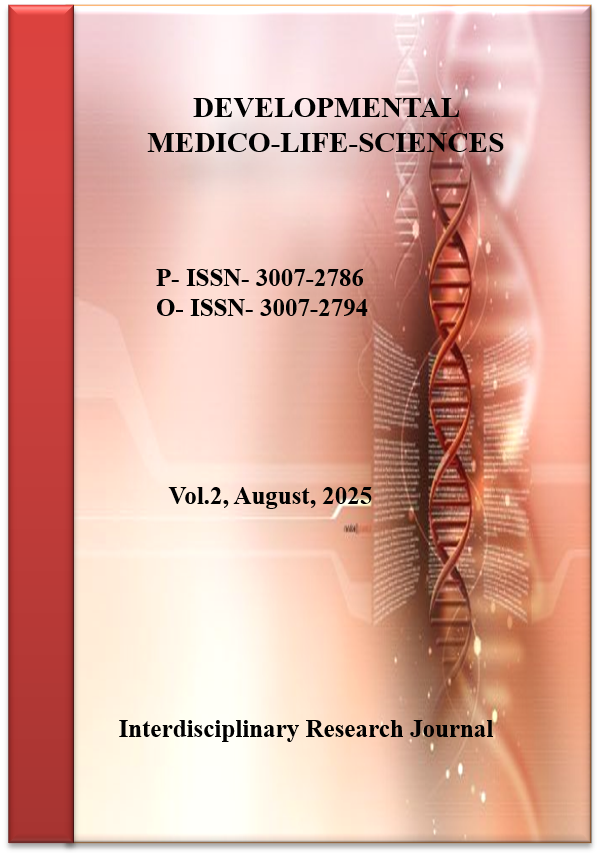Association Between Vitamin D Deficiency and Bone Mineral Density in Type 2 Diabetes: A cross-sectional study
Vitamin D Deficiency and Bone Mineral Density in Type 2 Diabetes
DOI:
https://doi.org/10.69750/dmls.02.08.0147Keywords:
Type 2 diabetes mellitus, vitamin D, 25(OH)D, bone mineral density, DXA, osteoporosis, hypovitaminosis D, South Asia, HbA1c, densitometryAbstract
Background: People with type 2 diabetes mellitus (T2DM) sustain more fractures than peers despite often normal areal bone mineral density (BMD). Vitamin D deficiency is common in South Asia and may worsen diabetic skeletal fragility.
Objectives: To assess the association between serum 25-hydroxyvitamin D [25(OH)D] and BMD in adults with long-standing T2DM.
Methods: A Multicenter cross-sectional study at two tertiary hospitals in Punjab, Pakistan was conducted. Current study enrolled 110 adults aged 40–75 years with T2DM duration ≥5 years. Fasting 25(OH)D was measured by LC–MS/MS. Lumbar-spine (L1–L4) and femoral-neck BMD were measured by DXA. Multivariable linear models related 25(OH)D (per 10-ng/mL and categories: deficient <20 ng/mL; insufficient 20–29; sufficient ≥30) to site-specific BMD, adjusting for age, sex, BMI, diabetes duration, HbA1c, eGFR, lifestyle factors, diet, and thiazolidinedione use.
Results: Participants were 57.2±8.6 years; 52.7% women; BMI 28.9±4.7 kg/m²; diabetes duration 10.5 years. Vitamin D deficiency and insufficiency were present in 62.7% and 24.5%. Each 10-ng/mL higher 25(OH)D associated with +0.029 g/cm² (95% CI 0.014–0.044) lumbar and +0.025 g/cm² (0.011–0.039) femoral-neck BMD. Versus sufficiency, deficiency associated with −0.071 and −0.056 g/cm² lower lumbar and femoral-neck BMD; insufficiency showed intermediate deficits. Associations were stronger in women and in participants with HbA1c ≥8%; no strong nonlinearity was detected.
Conclusions: Lower 25(OH)D independently relates to lower axial and femoral BMD in T2DM. Integrating vitamin D evaluation and correction into diabetes bone care is clinically prudent while fracture-endpoint trials are pursued.
Downloads
References
Hofbauer LC, Rachner TD, Hamann C, Schoppen S, Rauner M. Bone fragility in diabetes: novel concepts and clinical implications. Lancet Diabetes Endocrinol. 2022;10(4):284–296. doi:10.1016/S2213-8587(21)00347-8.
Li GF, Zhao PP, Xiao WJ, Karasik D, Xu YJ, Zheng HF. The paradox of bone mineral density and fracture risk in type 2 diabetes. Endocrine. 2024;85(3):1100–1103. doi:10.1007/s12020-024-03926-w.
Giangregorio LM, Leslie WD, Lix LM, Johansson H, Oden A, McCloskey E, et al. FRAX underestimates fracture risk in patients with diabetes. J Bone Miner Res. 2012;27(2):301–308. doi:10.1002/jbmr.556.
Leslie WD, Aubry-Rozier B, Lamy O, Hans D. TBS (trabecular bone score) and diabetes-related fracture risk. J Clin Endocrinol Metab. 2013;98(2):602–609. doi:10.1210/jc.2012-3118.
Leslie WD, Johansson H, McCloskey EV, Harvey NC, Kanis JA, Oden A, et al. Comparison of methods for improving fracture risk assessment in type 2 diabetes: The Manitoba BMD Registry. J Bone Miner Res. 2018;33(11):1923–1930. doi:10.1002/jbmr.3521.
Shuhart CR, Yeap SS, Anderson PA, Jankowski LG, Lewiecki EM, Morse LR, et al. Executive summary of the 2019 ISCD Position Development Conference. J Clin Densitom. 2019;22(4):453–471. doi:10.1016/j.jocd.2019.07.001.
Krueger D, Tanner B, Szalat A, Agarwal S, Shuhart CR, Shepherd JA, et al. DXA reporting updates: 2023 official positions of the International Society for Clinical Densitometry. J Clin Densitom. 2024;27(3):101437. doi:10.1016/j.jocd.2023.101437.
Gani LU, Sritara C, Blank RD, Chen W, Gilmour J, Dhaliwal R, et al. Follow-up bone mineral density testing: 2023 ISCD official positions. J Clin Densitom. 2024;27(1):101440. doi:10.1016/j.jocd.2023.101440.
LeBoff MS, Chou SH, Ratliff KA, Cook NR, Khurana B, Kim E, et al. Supplemental vitamin D and incident fractures in midlife and older adults. N Engl J Med. 2022;387(4):299–309. doi:10.1056/NEJMoa2202106.
Voulgaridou G, Christou GA, Chasan ZT, Goulis DG. Vitamin D and calcium in osteoporosis and the role of bone turnover markers: a narrative review. Nutrients. 2023;15(3):721. doi:10.3390/nu15030721.
Fischer C, de Jongh E, Kemmler W, Shojaa M, Beaudart C, Bruyère O, et al. Additive effects of exercise and vitamin D supplementation on bone mineral density: systematic review and meta-analysis. Osteoporos Int. 2023;34(8):1535–1550. doi:10.1007/s00198-023-06683-5.
Kong SH, Jang HC, Kim JH. Effect of vitamin D supplementation on risk of fractures and falls: a network meta-analysis. Endocrinol Metab (Seoul). 2022;37(2):274–284. doi:10.3803/EnM.2021.1374.
Demay MB, Autier P, Bouillon R, Dawson-Hughes B, Durazo-Arvizu RA, Gallo S, et al. Vitamin D for the prevention of disease: an Endocrine Society clinical practice guideline. J Clin Endocrinol Metab. 2024;109(8):1907–1947. doi:10.1210/clinem/dgae290.
Shah VP, Bauer DC, Bolland MJ, Bouillon R, Camargo CA Jr, Dawson-Hughes B, et al. Evidence review supporting the Endocrine Society guideline on vitamin D for disease prevention. J Clin Endocrinol Metab. 2024;109(8):1948–1970. doi:10.1210/clinem/dgae291.
Cui A, Ma Y, Zhou F, Xiao P, Fan Z, Zheng J, et al. Global and regional prevalence of vitamin D deficiency from 2000 to 2022: a systematic review and meta-analysis. Front Nutr. 2023;10:1070808. doi:10.3389/fnut.2023.1070808.
Siddiqee MH, Bhattacharjee B, Siddiqi UR, Rahman MM. High prevalence of vitamin D deficiency among South Asian adults: a systematic review and meta-analysis. BMC Public Health. 2021;21(1):1823. doi:10.1186/s12889-021-11888-1.
Nimitphong H, Holick MF. Vitamin D status and sun exposure in Southeast Asia. Dermatoendocrinol. 2013;5(1):34–37. doi:10.4161/derm.24054.
Saito M, Marumo K. Effects of collagen crosslinking on bone material properties in health and disease. Calcif Tissue Int. 2015;97(3):242–261. doi:10.1007/s00223-015-9985-5.
Willett TL, Paschalis EP. A critical review of advanced glycation end products (AGEs) and bone: mechanisms and clinical relevance. Bone. 2022;164:116505. doi:10.1016/j.bone.2022.116505.
Rungratanawanich W, Qu Y, Wang X, Essa MM, Song BJ. Advanced glycation end products (AGEs) and other adducts in aging-related diseases and alcoholic tissue injury. Exp Mol Med. 2021;53(2):168–188. doi:10.1038/s12276-021-00561-7.
Martínez SB, Blanco-Rojo R, Vaquero MP. The diabetic paradox: bone mineral density and fracture in type 2 diabetes. Endocrinol Nutr. 2016;63(9):495–501. doi:10.1016/j.endonu.2016.06.004.
Chen RD, Wei XJ, Tian JH, Yang KH, Cao X. Hypoglycemic agents and bone health: a systematic review and meta-analysis. Front Endocrinol (Lausanne). 2023;14:1022279. doi:10.3389/fendo.2023.1022279.
Viscoli CM, Inzucchi SE, Young LH, Insogna KL, Conwit R, Furie KL, et al. Pioglitazone and risk for bone fracture: safety data from a randomized clinical trial. J Clin Endocrinol Metab. 2017;102(3):914–922. doi:10.1210/jc.2016-3177.
Colhoun HM, Livingstone SJ, Looker HC, Morris AD, Wild SH, Lindsay RS, et al. Hospitalised hip fracture risk with rosiglitazone and pioglitazone use compared with other glucose-lowering drugs. Diabetologia. 2012;55(11):2929–2937. doi:10.1007/s00125-012-2668-0.
Chen W, Sun J, Li Y, Liu J, Wu H. Fracture risk assessment in diabetes mellitus. Front Endocrinol (Lausanne). 2022;13:961761. doi:10.3389/fendo.2022.961761.






















